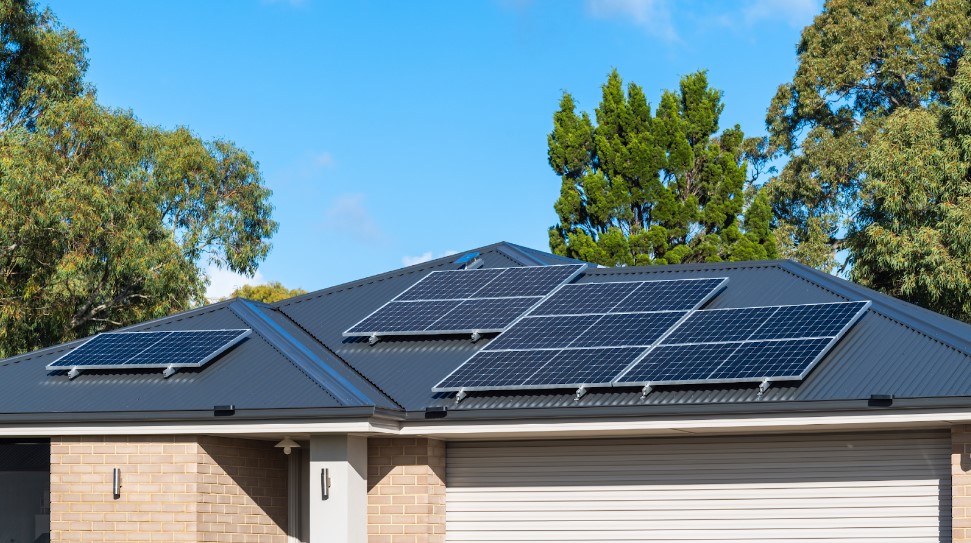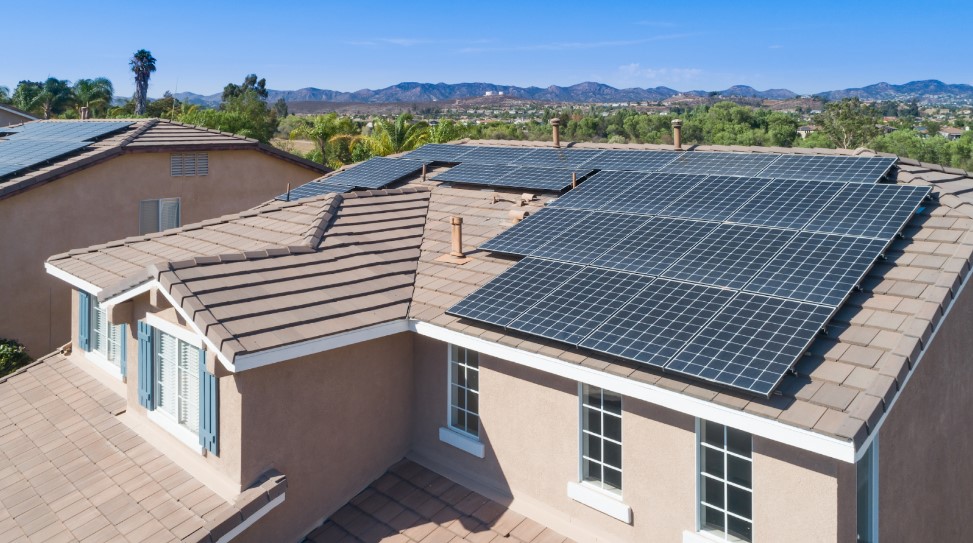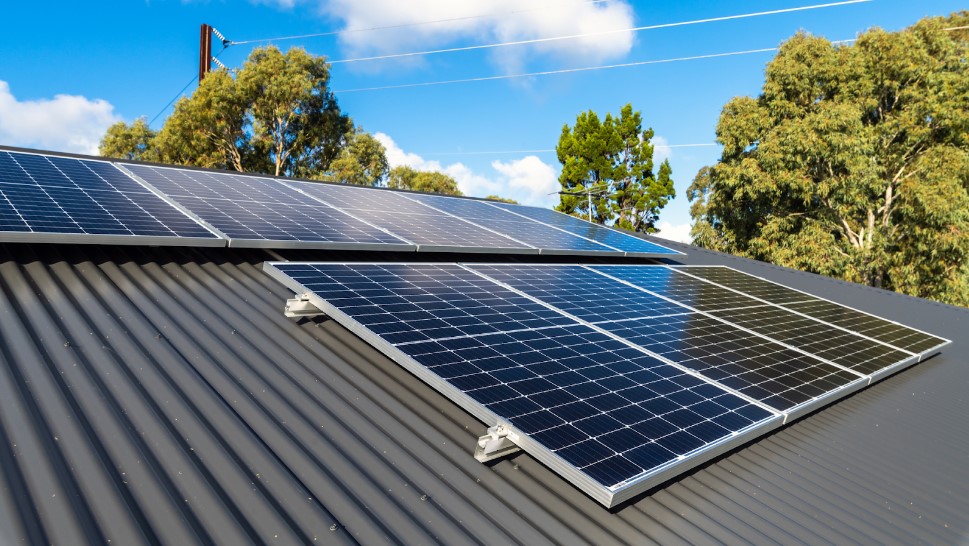There are significant benefits to having a home solar panel system in California. Even with NEM 3.0 — solar systems help homeowners lower their utility bills and power their homes through clean energy.
Based on the financial benefits of solar, you may consider installing a solar system on your home. Most homeowners opt for rooftop solar, as it’s typically cheaper than ground-mounted systems. One of the first steps in the process involves assessing your roof for its structural integrity. Another consideration is the type of roof your home has on top — let’s find out what roof materials are optimal for solar panels.
Enact Solar serves as a trusted advisor for homeowners looking to go solar and monitor their solar systems. We connect homeowners with custom solar panel systems, designed for their homes on our solar software.
What type of roof is best for solar panels in California?
The best roof for solar panels is a structurally sound roof that can last for 25 years or more. Solar panels can last for 25 or more years, which is why you want a roof that will last longer. Solar installers in California can work with a variety of roofing materials, though some are easier than others.
Generally speaking, the best roofing materials for solar panel installation are asphalt shingles or metal roofs. While a qualified installer with experience can work with most roofs, these two stand out.
The majority of California homes have asphalt shingle roofs, making them an installer favorite. Asphalt shingles are relatively inexpensive, which makes replacing or repairing them cheaper. The installation process is relatively simple and is the most familiar for installers across California. An installer will drill into your roof to install the mounting equipment with a lag bolt and flashing to protect against water damage.
Metal roofs are another strong contender for solar. Standing seam roofs are strong, resistant to all kinds of weather and can last for decades. Most installers are familiar with metal roofs and how to bolt in mounting clamps to support solar panels, protecting the integrity of your roof without the need to drill or replace shingles/tiles.
What roof types are common in California?
Asphalt Shingles
Asphalt shingle roofs are the most common roofing material in California and across the United States. An asphalt shingle roof is a roof made of asphalt shingle tiles, which typically are made with fiberglass. Asphalt as a material is both durable and flexible. The roofing material is typically the most affordable for homeowners and can come in many different colors. Due to these factors, asphalt shingle roofs are versatile for homeowners from Northern California to Southern California.
An asphalt roof typically lasts 10-30 years. Homeowners who choose higher quality asphalt shingles and work with trusted roofing companies can maximize the life of their roof. Solar panels can last 20-25 years, so you don’t want a roof with a shorter lifespan than their panels.
Since asphalt roofs are the most common roofing material across California, this makes them easiest for solar installers to work on. A qualified installer will drill studs into your roof and attach the mounting equipment. To prevent water leakage, the installer will seal the space between the studs and shingles with a metal plate and sealant.
What are the pros and cons of an asphalt shingle roof?
- Pros: Most common roofing material in California; compatible with solar panel installations; relatively easy to drill into and secure mounting brackets.
- Cons: Less durable than some other materials and may require replacement or maintenance sooner.

Metal Roofing
Metal roofing is another great fit for solar panels due to their durable and non-flammable material. Metal roofs are typically made of strong metals — such as tin, aluminum, zinc, copper and steel. A metal roof can last for 40-70 years or more, making it more durable than asphalt shingles. Metal roofs also reflect light and heat, which can reduce the cost of keeping your house cool. However, a downside of metal roofing can be its higher cost.
Solar installers can install solar panels on a metal roof. There are different types of metal roofing, with different installation methods. Overall, metal roofs are a good choice for solar panels.
Solar for a standing seam metal roof
A standing seam metal roof is a type of roofing system made from metal panels with raised seams that interlock to create a continuous surface. The seams, or vertical legs, rise above the panel’s flat area, providing durability and a sleek appearance. These roofs are known for their weather-tightness, longevity and resistance to extreme weather conditions. They typically feature concealed fasteners, which enhance their aesthetic appeal and minimize maintenance needs.
There are a few ways to install solar panels on a standing seam metal roof. Your installer can use mounting clamps, which is a simple process with no drilling involved. There are alos adhesive thin-film panels that can be installed on roofs without the need for racking and mounting clamps.
What are the pros and cons of a standing seam metal roof?
- Pros: Extremely durable; easy to attach solar panels without drilling; often comes with a lifespan that matches or exceeds solar panel warranties.
- Cons: Higher initial cost compared to asphalt shingles.
Solar for corrugated and trapezoidal rib metal roofs
A corrugated metal roof is a type of roofing system made from metal sheets that are formed into a repetitive wavy pattern, or corrugation. This solar panel design increases the sheet’s strength and durability, making it ideal for roofing applications.
Corrugated metal roofs don’t have adequate seams for clamps — meaning solar panels need to be attached with traditional mounting equipment. An installer will likely drill into your roof and use special mounting brackets either in the peaks or valleys of the corrugated roof. The installer will use sealant to cover the screwed sections and prevent leaks. Drilling into your roof may void its warranty, be sure to check with your warranty before going solar.
Trapezoidal rib metal roofs are similar to corrugated roofs – both are exposed-fastened roofs. An installer will likely drill into your trapezoidal rib roof to install special mounting brackets. The installer will apply sealant to prevent water from leaking in,
What are the pros and cons of a corrugated metal roof?
- Pros: Durability and energy efficiency; lower-cost than standing seam metal roof; good roof material for solar.
- Cons: Higher initial cost compared to asphalt shingles
Clay Tile and Concrete Tile Roofs
While most homeowners in California have asphalt shingles, many associate red clay and concrete tiled roofs with the Golden State. Clay and concrete tile roofs — sometimes called Spanish tile or terra cotta tile — can last for 50 to 100 years or more and offer California homeowners efficient insulation against heat. However, the drawbacks of this roofing material include brittleness. Although clay tiles are resistant to wind, fire, rain and hail — individual tiles are brittle and can easily break during installation. Clay tiles also cost significantly more than other roofing materials.
Solar panels can be installed on clay or concrete tile roofs but require a more involved process. Unlike simple installations on asphalt roofs, solar panels need to be carefully installed to prevent damage and leaks. Installations on tile roofs are more labor intensive, which can drive up costs. Additionally, due to liability concerns, some installers may not install on clay tile roofs.
When looking to go solar, it’s important to find an installer that has experience with clay or concrete tile roofs
What are the pros and cons of a clay or concrete tiled roof?
- Pros: Long-lasting; provides good architectural aesthetics for California neighborhoods.
- Cons: Fragile and can crack during installation; requires specialized mounting hardware and careful installation; not all installers work with clay or concrete tile roofs.
Wood and Cedar Roofs
Some homes have wood shake or wood shingle roofs, which offer homeowners an aesthetic roof material that provides insulation. Wood does not conduct heat, making it a great insulator. Additionally, wooden roofs are resilient to wind damage. A wood roof can last between 15-50 years, depending on the quality of materials and other factors. The disadvantages include high upkeep to prevent wood rot. Wood is also a flammable material, which adds certain risks.
Solar panels are lightweight and can be installed on a wood roof. However, due to the flammability of wood, some municipalities and jurisdictions prohibit the installation of panels on wood roofs. If you live in an area that prohibits installation on wood roofs, you can decide to re-roof or try ground-mounted solar panel systems.
Similar to asphalt shingles, an installer will drill into your roof — insert a flashing to weatherproof the area — to install the mounting equipment. A qualified installer with experience can install solar panels on a wood or cedar roof, if your jurisdiction allows.
What are the pros and cons of a wood shake roof?
- Pros: Aesthetic appeal in certain architectural styles.
- Cons: Less fire-resistant; less durable; solar installations may be prohibited in certain California jurisdictions.

How are solar panels installed on an asphalt shingle roof?
Installing solar panels on asphalt shingle roofs is a common and efficient process due to the material’s compatibility and widespread use. Here’s a step-by-step overview:
- Custom Design: Enact’s team of home energy advisors design a solar system tailored to your roof’s specifications.
- Assessment: The first step involves a thorough roof inspection to ensure it can support the solar panels’ weight. An assessment of the roof’s condition and orientation is also conducted to maximize sunlight exposure. Necessary permits are obtained from local authorities to comply with building codes and regulations.
- Mount Installation: Mounts are attached to the roof, serving as the foundation for the solar panels. Flashing is used to seal the mounts, preventing water leakage. This step involves drilling into the shingles and roof rafters to securely anchor the mounts.
- Racking: Rails or racks are installed onto the mounts, providing a stable structure to support the solar panels. These racks ensure the panels are positioned at the optimal angle for sunlight exposure.
- Panel Installation: Solar panels are securely attached to the racking system. Electrical wiring is connected, linking the panels to an inverter, which converts the generated DC electricity into usable AC power.
- Connection and Testing: The system is connected to your home’s electrical system. Technicians perform thorough testing to ensure the system operates efficiently and safely.
This straightforward process allows for efficient solar panel installation on asphalt shingle roofs, providing a renewable energy source for your home.

How are solar panels installed on a metal roof?
Similar to other roofing types, the process starts with a roof inspection and assessment to ensure its structural integrity. Enact’s home energy advisors will then design a custom system tailored to your home’s architecture, energy needs and budget.
Solar panels can be installed on metal roofs using either penetrating or non-penetrating mounting systems. The optimal system depends on the type of metal roof, namely whether it’s a standing seam or corrugated metal roof.
Corrugated Metal Roofs:
- Penetrating Mounts: Due to the lack of sufficient seams for mounting clamps, screws are often used to penetrate the roof to install mounting equipment. Sealant is applied to cover the holes to prevent leaks.
- Adhesive Thin-Film Panels: These panels can be used to avoid drilling holes, adhering directly to the roof’s surface.
Standing Seam Metal Roofs:
- Non-Penetrating Mounts: These roofs have built-in seams that allow for attaching solar panels without drilling holes. Clamps or brackets can be used to secure the panels directly to the seams.
- Grab System: This method involves using clamps that attach to the seams, providing a secure and non-invasive way to mount the panels. This approach is often quicker and more cost-effective as it doesn’t require drilling or additional rails.

Why do some installers not work with clay tile or concrete tile roofs?
Some installers avoid working with clay tile or concrete tile roofs due to several challenges these materials present. Both types of tiles, while durable, are relatively fragile and can crack or break easily during the installation process. This fragility increases the risk of damaging the tiles, leading to costly repairs and potential leaks.
Installing solar panels on these roofs requires specialized techniques and additional labor to avoid damaging the tiles. This often involves removing and replacing individual tiles with mounting brackets, which is time-consuming and requires skilled labor.
Concrete tiles are significantly heavier than other roofing materials, which can complicate the installation process and require additional structural support to handle the combined weight of the tiles and solar panels.
Drilling into clay or concrete tiles can compromise the roof’s waterproofing, increasing the risk of leaks. Special care and additional sealing materials are necessary to maintain the roof’s integrity, adding to the complexity and cost.
Can you install solar panels on a flat roof?
Yes, solar panels can be installed on homes with flat roofs and successfully generate clean electricity. There are some considerations with installing solar panels on a flat roof — namely, solar panels should never be installed horizontally. Additional considerations include ensuring proper water drainage and avoiding covering vents or exhaust fans.
Solar installations on flat roofs require additional mounting equipment to orient the panels and optimize power generation. Because flat roofs aren’t limited to the roof pitch, installers can find the right tilt, angle and direction to help you get the most out of your solar investment.
Enact’s team of energy home advisors can create custom solar proposals for homeowners with flat roofs. Using Enact’s solar design platform, your advisor can design a customizable solar panel system tailored to your home, energy usage and budget.
Will I need a new roof before going solar?
Solar panels can last 25-35 years, which means you will need a roof that will last for the same amount of time. If you own a new home or a home with a new roof, you might not need to replace your roof before going solar. For some homeowners, a new roof is recommended before going solar.
Asphalt roofs are typically the most common type of roof material. If your home has an asphalt roof over 10 years old — we recommend getting a new roof. A new roof can cost anywhere from $15,000-$30,000 — depending on material, size, roofing contractor and other factors.
While a new roof sounds expensive, roofs and solar panels have similar lifespans and solar savings will pay back the cost of their system and the new roof over time. The cost of removing and re-installing solar panels can cost anywhere from $300-$1000 per panel on top of any roof repairs and replacements needed after going solar.
Before going solar with Enact, a local professional will evaluate your roof’s integrity to determine if your roof will need repairs or replacement. Enact customers can back out of the purchase if the cost of replacement is too high for their budget.
Will solar panels damage my roof?
While there will always be risk, solar panels should not damage your roof when correctly installed by a professional technician. Enact works with vetted solar installers to help California homeowners go solar and improve the installation experience.
Solar panels can protect your roof from the elements, such as sunlight. This can slightly extend the longevity of your roofing material’s life. Additionally, by shielding your roof from the sun — solar panels can help keep your roof cooler than the outside temperature. This may have a positive effect on keeping your attic climate cooler.
Get a custom quote made for your California home
If you want to go solar or learn if your roof qualifies for solar, schedule a complimentary consultation with an Enact home advisor. Enact customers get a free custom solar panel proposal during their consultation.
Our knowledgeable team of advisors will design a solar panel and energy storage system for your home, using Enact’s design software. If you want to add a storage battery or electric vehicle charger to your system, Enact can incorporate them into your system.
Once you find the right system for your home, Enact will coordinate with a trusted solar installer in your community. Enact customers are informed throughout the process, from design to post-installation monitoring with the Enact Home app.
What sets Enact apart from our competition is transparency and choice. As an Enact customer, you get a choice in what solar panels, inverters and batteries are included in your system. We work with California homeowners to find the right system for their unique situation. Enact also works with a vast variety of payment and financing options.
Schedule a free consultation today and get a free custom proposal, made for your home. It’s never too late to learn about how the financial and environmental advantages of solar can benefit you.

